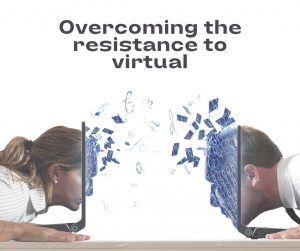 The past few months have certainly been challenging with leaders and their teams, weary from lockdowns and business uncertainty, experiencing a distinct lack of enthusiasm for the continuation of virtual meetings. We are seeing this translate into behaviours such as attending online meetings with no camera, remaining on mute for the duration and contributing the bare minimum when asked to speak.
The past few months have certainly been challenging with leaders and their teams, weary from lockdowns and business uncertainty, experiencing a distinct lack of enthusiasm for the continuation of virtual meetings. We are seeing this translate into behaviours such as attending online meetings with no camera, remaining on mute for the duration and contributing the bare minimum when asked to speak.
Face-to-face meetings are looked back on fondly – almost with a halo effect – yet if we wind the clock back and are truly honest, many of us didn’t much like face-to-face meetings either, unless they were focussed and essential.
This lockdown is amplifying the reality that different meeting skills are required for virtual success and with the rise of the hybrid workplace, this is not a reality that will go away. Leaders who are not prepared to ensure themselves and their teams are upskilled in this new way of work set themselves, their performance, and their organisations back.
Four simple tips
Bringing enthusiasm and focus back to virtual meetings is possible using one or a combination of these simple techniques:
Breakout rooms – If we simulate what happens in a face-to-face meeting, it is that participants group together in twos or threes as they enter the room and have a chat – they connect. How can leaders create unique ways for people to do this in an online scenario? One tool I use is to add a couple of people to breakout rooms as they enter the meeting, replacing the upfront lethargy and awkward pauses with chat, laughter, and an opportunity for connection before the meeting starts.
Questions – think of some great questions ahead of time that encourage sharing and allows participants to “loosen up” before concentrating on the task at hand. For example, in one meeting recently a team member mentioned what his 19-year-old son was up to. That naturally invited the question to share what we were all up to when we were 19, a conversation that built camaraderie, trust, and humour.
Context – when a meeting leader can provide context ahead of time, for example why the meeting is needed, what’s expected from participants, perhaps issuing some pre-reading for discussion, then attendees are showing up and interacting with purpose.
Meeting size – consider the number of participants ahead of time. Having 4 or 5 people in one group is a suitable size, any more than that and it’s time to consider using breakout rooms. Ask questions and invite participants to consider the meeting content in groups of two or three for 10 minutes or so and then come back with a summary of the group’s ideas and discussion.
Simple actions like these don’t have to take a long time and often make for a more enjoyable meeting experience.
We’ve spoken before about the pandemic amplifying leadership gaps, particularly when it comes to building trust. Successful virtual meetings and hybrid workplaces will necessarily require a relinquishing of control. Many leaders find this difficult, and it will take a shift in mindset and behaviours to successfully lead a high-performance team in the future we’re all facing.
To discuss more tips or a facilitation session for your leaders and their teams, let’s have a conversation.









